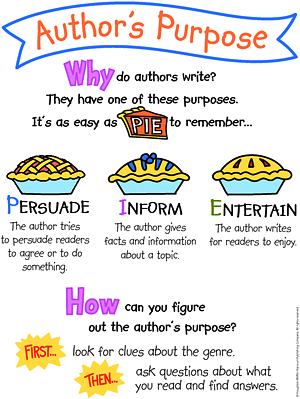Reading: Author’s Purpose
Reading: Author’s Purpose

Authors have a specific reason for writing a text. Identifying the author’s purpose helps readers understand the text and understand what the author wants the reader to learn.
Read the chart at right and notice the acronym PIE. There are three purposes authors have when writing: to persuade, to inform, and to entertain.
- Persuade: The author tries to persuade readers to agree or to do something.
- Inform: The author gives facts and information about a topic.
- Entertain: The author writes for readers to enjoy.
The genre of the text is the type of writing it is. There are many genres of texts, and we have already read several. Spoon is a fantasy. We Are Super Citizens and Meet the Dogs of Bedlam Farm were informational texts.
There are clues that might give us a signal as to the type of writing it is.
- When I see photographs with captions, I think that I will be reading an informational text.
- Asking and answering questions about details, illustrations, and text features will help me figure out the author’s purpose.

We will practice identifying the author’s purpose when we reread parts of Spoon. It has illustrations, so I think I am going to read a story.
To find the author's purpose in Spoon, you may discuss the questions below with someone.
Parent/Guardian: Check the student's responses with the answer key
, Reading: Author's Purpose (1.2.3).
- pp. 44-47:
- What clues tell you what kind of text you are reading?
- Why do you think the author wrote the story?
- pp. 51-56:
- What new clues about the genre have you found?
- What do you think is the author’s purpose for writing this text?
Texas Tech K-12
-
Address
Texas Tech Plaza | 1901 University Ave, Lubbock, TX 79401 -
Phone
(800) 692-6877 -
Email
ttuk12@ttu.edu

